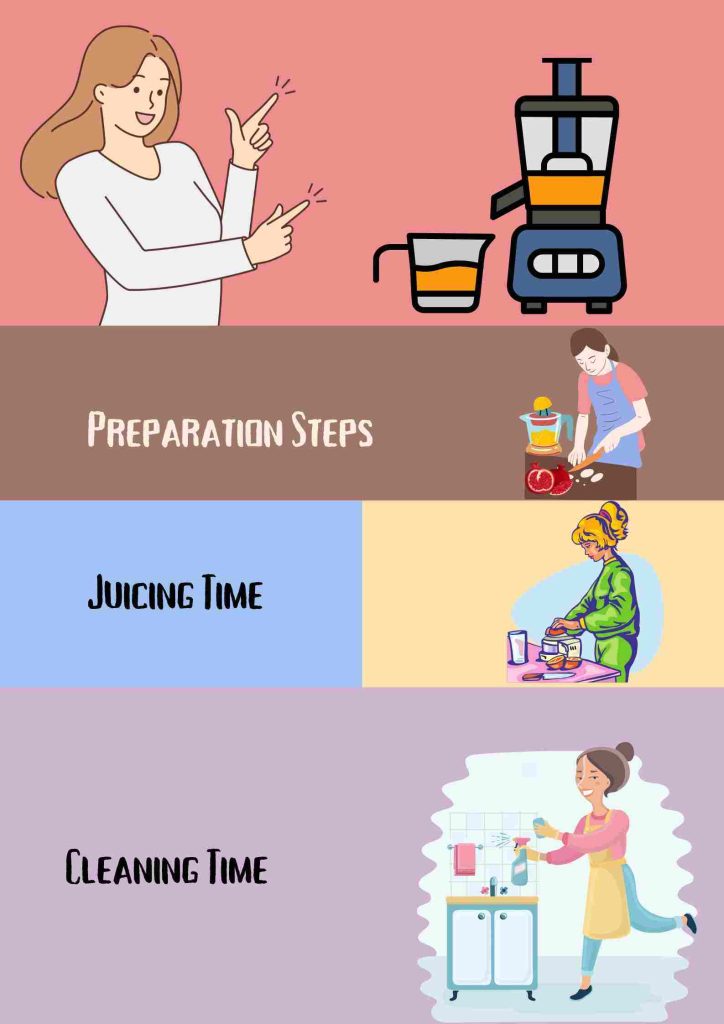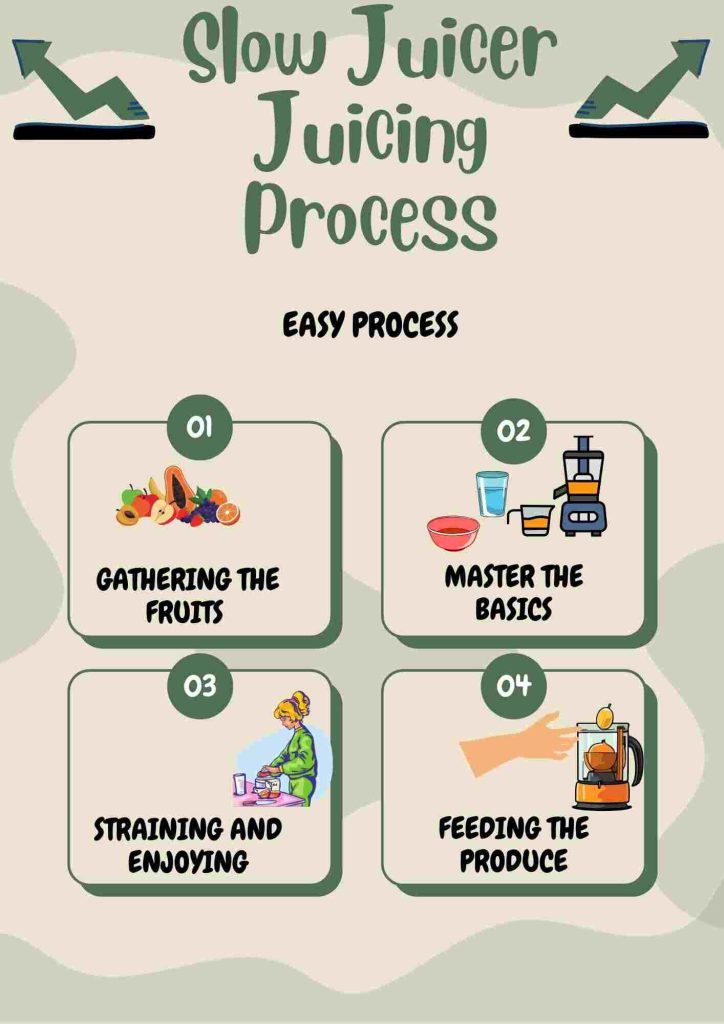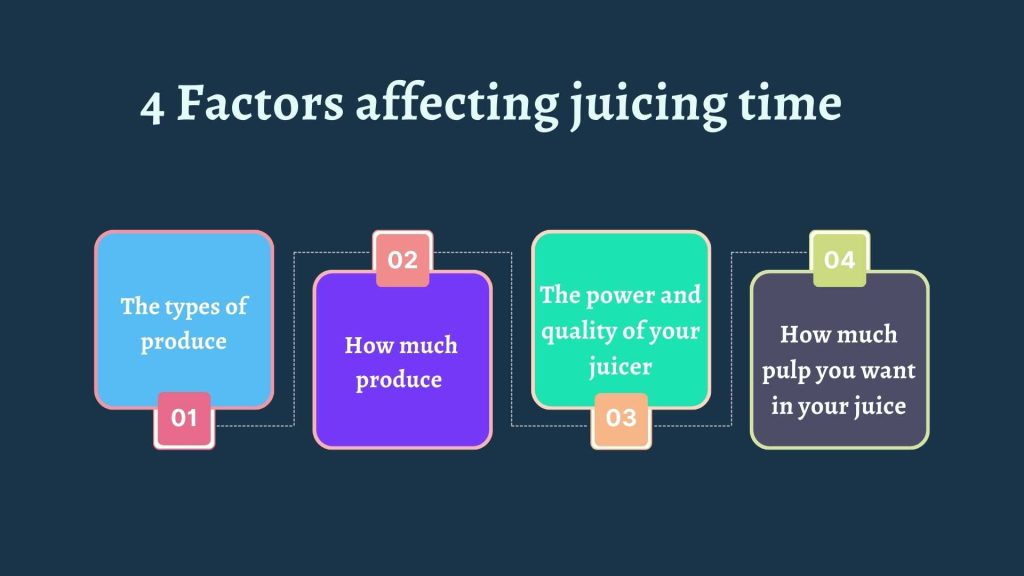Slow juicers are becoming increasingly popular. They can extract more juice and nutrients from fruits and vegetables. But how long does it take to make juice with a slow juicer?
If you want to make fresh juice at home, you might wonder how long a slow juicer will take. The good news is that it doesn’t take long at all! You can have fresh, delicious juice with a slow Juice.
In this guide, I put three top-rated slow juicers to the test. I get real-world results on how long you can expect the juicing process to take based on the produce you’re using.
So, in this guide, I’ll share factors influencing the duration. I’ll also provide valuable tips to help you enjoy fresh, nutritious juice more. So, Let’s go to start.
How long does it take to make juice with a slow juicer?
It depends on your response. The juicing time can vary greatly depending on your specific ingredients and amounts. But, the total time from start to finish usually takes me around 20-30 minutes. Making juice with a slow juicer requires three steps: preparing, juicing and cleaning. Here, I discuss each step.

1. Preparation Steps
To get started, I gather all my ingredients-usually 3-4 pounds of produce like apples, carrots, beets, kale, and ginger. Then, I wash, peel, and chop everything into small pieces to fit through the juicer chute. This prep step typically takes 10-15 minutes.
Next, I turn on my slow juicer and feed everything through the chute. The juicing itself usually takes 5 to 10 minutes for a typical batch. I go slowly, putting light pressure on the pusher to allow the auger time to do its work. Patience is key here. Rushing can lead to clogs or less efficient juicing.
Once done juicing, I turn off the machine and disassemble the parts to rinse everything clean. This whole process, from start to enjoyment, usually spans 20 to 30 minutes for me. The active time needs to be increased. Factoring in prep, cleaning, and enjoying the fresh-pressed juice is a reasonable time estimate for most casual juicers.
The time can vary depending on the specific equipment and amounts. But with some practice, you’ll get into a steady routine. And the benefits of homemade juice from a slow juicer are well worth the time invested! Fresh juice on demand – what could be better?
2. Juicing Time
When I started juicing, I didn’t realize how long the process would take. My first attempt with a slow masticating juicer took nearly an hour to make a single glass of juice! Over time, I’ve become much more efficient and can make a few juice glasses in about 30-45 minutes.
The actual juicing time can vary depending on a few factors:
The types of produce
Hard, dense veggies like beets, carrots, and ginger take longer to juice. Leafy greens or citrus juice faster. Creating juice blends with a mix of hard and soft produce provides the best balance between nutrition and juicing efficiency.
The quantity of produce
Juicing more fruits and vegetables will increase the total juicing time. I typically juice about 3-4 pounds of produce to make 3-4 glasses of juice. Any more than that, and I’m spending all morning at the juicer!
The specific juicer model
Some slow juicers are faster and more potent than others. Premium models with advanced drills and higher wattage motors generally juice quicker. My Omega juicer is on the higher end and can juice most recipes in 30-40 minutes.
Slow juicing does require some patience. However, the flavor and nutrition you gain from fresh, homemade juice make it worth the time spent. Once you get into a routine, you’ll be whipping up juice in no time! The key is finding what works for your schedule to make juicing a sustainable habit.
3. Cleaning Time
Cleaning a slow juicer does take a bit of time, but it’s worth it for the healthy juice. As an experienced home cook, I’ve found a few tips to streamline the process.
After juicing, the first thing I do is disassemble all parts of the juicer. It includes the feed chute, filter basket, auger, and juicing screen. It also consists of the pulp container and juice container. Then, I rinse everything under warm running water to remove excess pulp and juice. For stuck-on bits, I use a vegetable brush.
Soaking
I fill the sink with hot, soapy water for a deep clean and let all parts soak. I use a natural degreaser like lemon juice or vinegar in the water. Letting everything soak loosens caked-on fibers and makes scrubbing easier. After 30 minutes, I scrub each part with the vegetable brush and rinse with water.
Drying
Once cleaned, I dry all parts with a towel to prevent water spots. I then reassemble the juicer parts so they’re ready to go for my next juicing session.
Some people prefer to air-dry parts entirely before reassembling and storing them. Either way works, as long as you dry the juicer to prevent the growth of mold or bacteria.
While cleaning can take 30-45 minutes, I’ve found ways to cut the time. Soaking the parts and using a quality vegetable brush cuts down on scrubbing. And enlisting help from family members gets the job done faster.
With regular juicing and cleaning, disassembling and reassembling the juicer becomes second nature. The health benefits of fresh juice made at home make the time spent cleaning well worth it.
Slow Juicer Juicing Process
Making fresh juice with a slow juicer is a process that requires some patience, but the results are well worth it. As an avid juicer for over ten years, I’ve learned a few tips and tricks to make the most of my juicing sessions.

1. Gathering the Produce
The first step is selecting fresh, organic produce to juice. Some of my favorites for juicing are apples, carrots, leafy greens like kale and spinach, beets, and citrus. Wash all produce thoroughly before juicing. For leafy greens, removing the stems can help the juicing process.
2. Assembling the Slow Juicer
Next, assemble your juicer parts. These include the feeding chute, blade basket or grating disk, pulp container, and juice container. Connect all parts and place the pulp container under the grating disk to catch the pulp. Place the juice container under the spout to catch the extracted juice.
3. Feeding the Produce
Now you’re ready to start juicing! Feed the produce into the feeding chute. Apply firm and even pressure to push the produce through. For leafy greens, bundle them together. Alternate between soft and hard produce for the best results.
4. Straining and Enjoying
Once done juicing, you may strain the juice to remove any leftover pulp or sediment. Then, pour your fresh juice over ice or enjoy immediately. Most juices made with a slow juicer should be consumed within 3 to 5 days for the best quality and nutrition.
Juicing with a slow juicer takes time and effort. By following these basic steps, you’ll enjoy the freshest, healthiest juice in no time.
Factors affecting juicing time
When it comes to slow juicing, the time it takes varies depending on a few key factors. As an avid home cook and juicer, I’ve found that the main things that determine how long I’ll be standing there feeding veggies and fruits into my juicer are:

The types of produce
Hard, dense veggies like beets, carrots, and celery take longer to juice compared to leafy greens like kale or spinach. The juicer has to work harder to extract juice from more challenging produce. A recipe with a mix of both hard and soft produce provides the most balanced juicing time.
How much produce
The more fruits and vegetables I add to the juicer, the longer it will take to juice. I know I’m in for the long haul when making a big batch of juice for the whole family! For quicker juice, I stick to 3 to 4 ingredients.
The power and quality of your juicer
A more powerful juicer with a strong motor can produce juice faster than a lower-powered model. Higher-quality juicers are also more efficient, so you’ll get more juice in less time. My Breville juicer can make a glass of juice in under 5 minutes, while my old juicer could take up to 10 minutes for the same amount.
How much pulp you want in your juice
The pulp setting on your juicer also affects time. If I want smoother juice with less pulp, I run it through the juicer longer. For a chunkier juice with more texture, I don’t need to juice as long. I usually go somewhere in the middle – not too smooth, but not too pulpy.
While there’s some variation, a typical recipe uses 3 to 5 mixed fruits and veggies. It takes me between 5 and 10 minutes to juice. It depends on these factors. The good news is that slow juicing requires patience. The delicious, nutritious results are well worth the time!
Tips for faster juice make
When it comes to making juice with a slow juicer, patience is vital. But you can still speed up the process a little bit. After years of testing different tips and tricks, here are a few ways I’ve found to get juice out of a slow juicer faster:
Cut produce into small, uniform pieces
The smaller the pieces of fruits and veggies you put in the juicer, the less work the motor has to do. I aim for chunks no larger than 2 inches.
Alternate soft and hard produce
Feeding in a mix of soft, leafy greens like kale and romaine helps the juicer run more efficiently. Also, including more brutal roots like beets and carrots improves its performance. The soft greens are a buffer between the hard veggies, preventing them from getting jammed up.
Use the tamper tool
If your slow juicer comes with a tamper tool, use it frequently to push the produce into the feed chute. It helps the juicer grab onto the produce better and pull it through faster. But be very careful not to force the tamper and jam the motor.
Remove the pulp frequently
As the pulp container fills up, the juicer has to work harder to continue juicing. Empty the pulp every few minutes to allow the juicer to run freely. This simple step can speed up your juicing time by up to 30%!
Consider a larger feed chute
If you juice often, a slow juicer with a wider 3-inch feed chute may be worth the investment. The larger chute means less chopping for you and faster juicing. Popular brands like Omega and Hurom offer models with larger chutes.
Following these tips, I can make a juice pitcher in 15-20 minutes. It used to take 30 minutes or more. Slow juicing at its fastest! The extra few minutes I save allow me to clean up and enjoy my fresh-pressed juice even sooner.
Final Thoughts
In the end, slow juicing requires more time and patience. But the health benefits and juice quality make it worthwhile for me. A slow juicer is an excellent tool for adding fresh fruits and vegetables to your diet while maximizing nutrition.
Start with some simple recipes to get used to the process. Then, get creative and devise your delicious combinations.
Happy juicing, and remember – slow down, be patient, and enjoy the journey.
xvideos,
porn,
hentai,
porn,
xnxx,
sex việt,
Phim sex,
mp3 download,
MÚSIC MP3,
Define Npv,
hentai,
free porn xx,
Tom Life Insurance Review,
Is It Better To Pay Credit Card Before Statement,
Anime xxx,
phim xxx,
Free MP3,
phim xnxx,
Chinese Sex,
phim xxx,
xtube,
Ncl Trip Insurance,
gay brasileiro xxx,
sex,
BR sex,
xxx,
How Does Apple Music Voice Work,
Jav hd,
December In Washington Dc,
black horny old man eat pussy,
sexo forte,
Hot Topic Canada,
Craigslist Search All,
Hentai haven,
sex,

Meet Joseph J. Williams, the renowned kitchen specialist who is integral to the kitchenusers.com team. With a passion for kitchen appliances and an unwavering commitment to delivering the best to kitchen enthusiasts, William has carved a niche in the world of kitchen technology.


